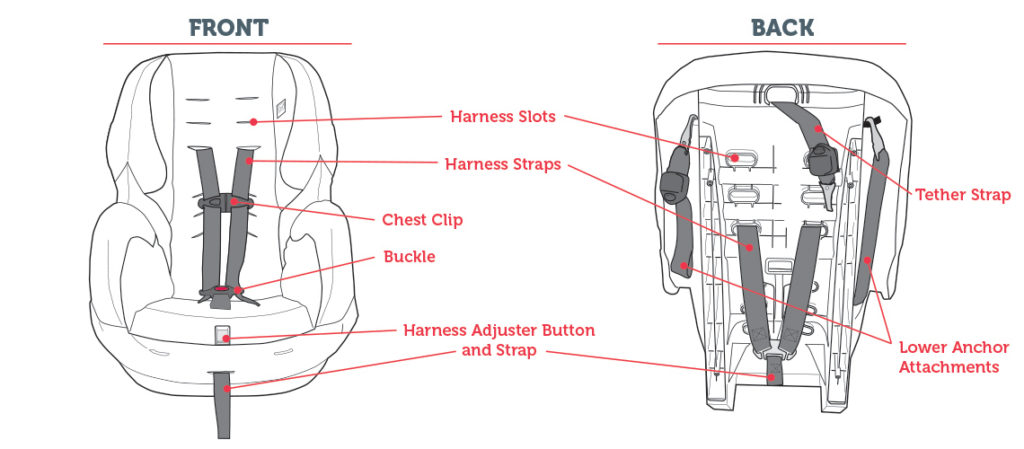
Preparing to go on a road trip? Add car seat safety to your check list! It can be a great time to familiarize yourself with the various car seat parts, labels, and instructions. Car seat language can confuse even the most informed parents. Understanding the different parts and how they work can help keep your child be as safe as possible every ride. Here is a guide to better understand the main parts of a car seat and their individual functions:
|
Harness straps These straps come over the shoulders and hips and attach to the buckle located at the crotch strap between the legs. The harness straps should be buckled and secured on every car ride. You will need to adjust them as your child grows. When you place a child into a car seat, you should not be able to pinch any harness material at the shoulder. The harness slots are the openings on a car seat that adjust the level of the harness straps. When using a car seat in the rear-facing position, the harness straps should be at or below your child’s shoulders. When forward-facing, the harness straps should be at or above the shoulders. You may have to look on the back of the car seat to see how to move the harness straps to different harness slots. Always look at the car seat manual for guidance and specific instructions for your specific seat. Harness adjuster Harness adjusters allow you to tighten and loosen the harness straps. When preparing your child for a car ride, especially in colder weather, remove any bulky coats or jackets and then tighten the harness straps. The harness adjuster may be located underneath fabric or close to the buckle. Chest clip The chest clip holds the shoulder straps together when buckled over your child’s chest. In the rear-facing and forward-facing positions this clip should be at armpit level. Internal injury could occur if the clip is placed too low over the soft parts of a child’s body. Always check the position of the chest clip every time you secure the child in the seat. Buckle Located between a child’s legs for rear and forward-facing car seats, this buckle secures the harness straps in place. A child should always be buckled into the car seat every time the vehicle is in motion even for feeding or during traffic. Lower anchor attachments These straps attach with clips on each end to the lower anchors found in most vehicle seats. You can use them as an option to secure most child safety seats instead of the vehicle’s seatbelt. Don’t use them together with a seatbelt unless the manufacturer’s instructions specifically state to do so. The lower anchor attachments with have two clips unlike the tether strap that will just have one clip. It is important to know the difference between the lower anchor attachments and the tether strap, so you do not mix them up when installing the seat. If you are not using the lower anchor attachments, refer back to the car seat manual to see how the straps should be properly secured in order to prevent them from causing injury to the child in the event of a motor vehicle crash. Tether strap This single seat-belt-like strap connects the rear of a child safety seat to an anchor point in the vehicle. These straps are typically only used in the forward-facing position to reduce the forward motion of a child’s seat and the child’s body in a crash. Anytime you are using a forward-facing seat, you should use a tether strap. Reference your vehicle’s manual for the exact location of these anchors so you don’t confuse them with cargo hooks. Your manual will show you the specific symbol to look for in your car to know where to attach the tether strap. |